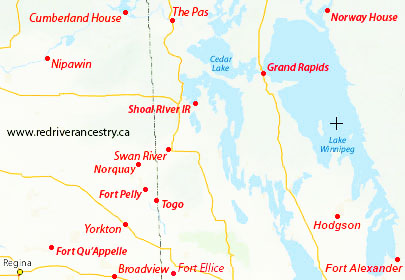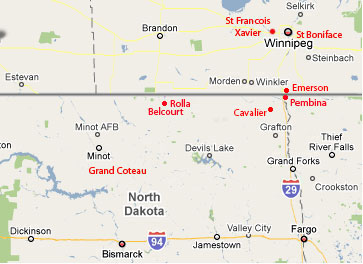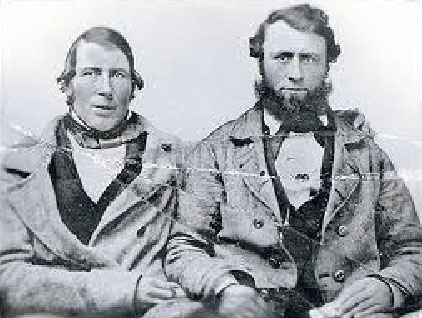PIERRE GUILLAUME "WILLIAM" SAYER (c1800-1868)
Pierre Guillaume (William) SAYER was born around 1800-1803 in the Lake Superior region, possibly at Lac la Pluie (Fort Frances area), the son of an Indian woman named Marguerite and John Charles SAYER (1782-1838). ** MORE ABOUT JOHN CHARLES SAYER
Pierre was a grandson of an Ojibway woman named OBEMAU-UNOQUA and John SAYER (1750-1818), an early fur trader of some renown who was born in England. ** MORE ABOUT JOHN SAYER
In 1812 Thomas DOUGLAS (1771-1820), LORD SELKIRK (Fifth Earl of SELKIRK), established an agricultural colony at the junction of the Red and Assiniboine Rivers (now Winnipeg). The North West Fur Company (NWC) saw this as an attempt by the Hudson's Bay Company (HBC) to drive them out of business.
1815-17: Friction between the HBC and NWC gradually escalated until Lord SELKIRK felt that only the presence of a military force in the colony would prevent bloodshed. In 1815 he went to Montreal and he returned the next year with a force of about 110 men, not as many as he had hoped. On his way back to Winnipeg he heard about the Seven Oaks Massacre of 22 settlers, including the colony's governor, Robert SEMPLE (1777-1816), at the hands of Cuthbert GRANT (1796-1854), the famous leader of the Métis. ** MORE ABOUT CUTHBERT GRANT SELKIRK detoured to Fort William, the inland headquarters of the NWC, eventually arresting most of the senior partners and taking control of the fort. A small contingent of soldiers carried on in the fall of 1816 to eventually retake Fort Douglas (Winnipeg) in January of 1817 SELKIRK followed with the rest of his men in the spring of the same year. His soldiers were given land grants close to the Forks and they called their settlement St Boniface.
Pierre Goes West
The HBC Archives presents us with an outline of Pierre’s whereabouts during the period from 1818 to 1832 and can be seen at this link: HBC ARCHIVES BIO of PIERRE GUILLAUME SAYER
In the spring of 1818 Pierre began his career as a voyageur (a canoe man, steersman, bow man, etc) in the employ of the North West Company (NWC) based at Cumberland House. Traditionally, in the late summer and fall voyageurs manned the canoes that transported trade goods originating from Lake Superior warehouses to the remote inland posts where they were traded for furs during the winter. In the spring and summer they plied the same water routes back, laden with furs that had been acquired during the winter trading season.
Union of the North West Company and the Hudson’s Bay Company
In 1821 the Northwest Company was absorbed by the Hudson's Bay Company ending many years of bitter conflict. Both companies had almost become bankrupt. The fur trade boom was nearing its end and the era of Red River settlement and agriculture was well under way.
Pierre at Fort Pelly
From 1828 to 1832 Pierre ended his career as a voyageur based at Fort Pelly in the Swan River District.
Fort Pelly was built in 1822 under the instructions of Sir John PELLY, Governor of the HBC. It was located on the elbow of the Assiniboine River about eight miles south of the present day village of Pelly. Its location was perfect because it was at the end of the portage between Swan River and the Assiniboine River. Goods could be sent to York Factory by a short portage to Swan River and then by following the water route. Alternately, goods could be transported to Fort Garry (Winnipeg) by just following the Assiniboine River. The fort was intended to be the center of the new Swan River District which included the Red Deer River, Swan River, Fort Dauphin, Brandon House and Fort Qu'Appelle. Bounded by Lakes Manitoba and Winnipegosis, the Red Deer River, Quill Lakes, Touchwood Hills and the Qu'Appelle Valley. Just north of the fort was an extensive forested area, excellent for furs such as beaver, fox, etc. The legendary Bard of the Prairies, Pierre FALCON lived in the area for a few years and no doubt Pierre got to know him well.
Pierre Retires to Red River
In 1832 Pierre was “Free to the Red River Settlement.”
The buffalo were essentially gone by this time. Europeans were flooding in to the Red River settlements, grabbing up the land and pushing the Métis out. They were fast becoming second-class citizens in their own land. Land ownership didn't mean much to them. To them, home was where you hung-your-hat. They were the nomads of the prairies, they moved about as necessity dictated.
As a Voyageur there was no further promotion available to Pierre. He would have to become a borgeois, and he must have been feeling the pinch because he couldn't resist doing a little free-trading on the side, just like his Dad used to do. This was definitely a No-No for HBC employees! The boss found out and Pierre was given his walking papers in 1832. He packed his things and headed for St Francois Xavier, just west of Winnipeg along the Assiniboine River, the White Horse Plains. A voyageur's career could be compared to that of a hockey player. He was 37 now, perhaps a little past his prime for a voyageur anyway.
St Francois Xavier was the center of the Red River Métis world, where Cuthbert GRANT (1796-1854) was King and Pierre FALCON was his Fiddler. Out of a job and considered an outlaw, a boot-legger of furs by the HBC, what else could Pierre do but enter into free-trading full-time. After all, his Dad had been successful at it (in fact he had retired a relatively wealthy man). Fur trading was the only life he knew, and he was good at it. But don't forget, the HBC had established themselves as the Government of the Day, they were The Law. It had taken them years of bitter competition to gain a monopoly on the fur-trade and now they had the power. You don't step on Superman's toes! They weren't about to tolerate this kind of activity! They wasted no time in decreeing that it was “Illegal to traffick in furs.”
Pierre had to be sly and wary to avoid his new foe, but when it came to cunning and stealth, there weren't many who could stand up to this guy! As a boy he had sat around camp-fires with His Grandpa and his Uncle (BIGFOOT and WAUB-O-JEEG), scarred old veterans of the Ojibwe-Sioux wars. They loved to boast of how they out-manoeuvred their enemies in war. Their words didn't fall on deaf ears with this kid! Also as a lad, he had travelled with his Dad, a veteran Free-Trader.
For the next 17 years PIERRE, and others like him, managed to evade the Law while eking out a fairly decent living. The furs had to go to buyers other than the HBC, however. There were runs to Kittson at Pembina and other locations in the US, sometimes involving travel through Sioux territory. (It must have been like the movie Thunder Road except canoes and Red River carts were the ‘hot-rods’ of that era). Furs were concealed in houses, in stables, in the woods along the rivers, in the bluffs of oak on the prairies. When the authorities found them, they were confiscated. Some accounts say that the most open and defiant free traders came from the Lower Red, in the parishes of St John's, Middlechurch and St Andrews
Nothing could be more distressing to Cuthbert GRANT than this outburst of contempt for the law. As Warden of the Plains, Sheriff and Magistrate, GRANT was bound to suppress it, but these were his own people! If he did his duty, he might forfeit the affection of his followers. If he didn't he would lose his offices and his income.
Pierre and Josephte FROBISHER
Pierre must have done well for himself because through all this he met and married (around 1835) a young lady by the name of Josephte “Josette” FROBISHER. She was also a first generation Métis, daughter of an Indian woman and Alexander FROBISHER, an Irishman. They marred at Grantown (Cuthbert GRANT's Town, St Francois Xavier) and had a dozen kids, most of them born while he was on the lam.
In 1844 eldest son Edward married Madeleine DELORME in St Francois Xavier, daughter of Madeleine VIVIER and Urbaine HENAULT dit DELORME (1802-1886).
Before his arrest, Pierre had been trading with Norman KITTSON (1814-1888) who was in direct competition with the HBC. ** MORE ABOUT NORMAN KITTSON in WIKIPEDIA
Arrested for Trafficking in Furs
It was inevitable, I suppose, that one day he'd get caught. On May 17, 1849, 54 year old Pierre Guillaume SAYER and three other Métis from the Red River Colony were brought to trial on the charge of violating the HBC charter by trafficking in furs.
Guillaume Sayer (left), with Louis Riel Sr. (right)
George Bryce: Possibly the case would be easily disposed of, and most likely dismissed with a trifling fine, although it was true that SAYER had mad a stiff resistance on his being arrested. This violent resistance was but an example of the bitter and dangerous spirit that was developing among the Métis. The day of the trial (May 17) was Ascension Day, a day of obligation among the Catholic people of the Settlement. It was noticeable that there was much ferment in the French parishes. Louis RIEL (the Elder), who was a violent, but effective speaker, of French, Irish and Indian descent, busied himself in stirringup resistance. The fact that it was a Church day for the Métis made it easy for them to gather together. This they did by hundreds in front of the St. Boniface Cathedral, where, piling up their guns, with which allthe men were armed, at the Church door. They then entered and performed their sacred duties. At the close of the service, RIEL, "the miller of the Seine," made a fiery oration advocating the rescue of their Compatriot (SAYER) who was to be held for trial at the Court House. A French sympathizer said of this public meeting: "Louis RIEL obtained a veritable triumph on that occasion and long and loud the hurrahs were repeated by the echoes of the Red River." As the court session began, a swarm of armed and menacing Métis were gathering outside. Pierre was the first of the four traffickers to be tried. As the prisoner stood up, the crowd surged forward shouting and demanding to be let in so they might shoot the Judge (THOM). Some of them ended up sitting in the jury box with their powder horns at their sides. When the trial proceeded, Pierre explained that he wasn't trading! He was only exchanging gifts with his relatives, like Indians do. (For the Defence: The angry mob outside) Hewas found guilty, but the jury recommended clemency on the grounds that the Métis genuinely believed they had the right of free trade. Satisfied that the rights of the Company had been upheld with the guilty decision, the Chief Factor requested that SAYER not be punished and withdrew the charges against the other men. When the four emerged "free" from the courthouse to the cheers of the crowd, both the Métis and the HBC, accepted this as recognition of the principal of free trade. From that point on, the HBC abandoned its claim to a monopoly and began open competition with other traders. The fur-trade (as a major economic entity) was slowly dying anyhow. Cuthbert Grant had sat on the bench as a magistrate in the trial. It was also his trial in a sense, the results of which greatly diminished his stature and popularity among his people. Métis of St Boniface and Pembina, men of the main river party of the buffalo hunt, were beginning to follow the lead of a newcomer, the Métis son of a Nor’Wester Voyageur by the name of Louis RIEL (the Elder RIEL). His son by the same namesake, Louis RIEL, would become the most famous Métis Leader of them all!
Around 1850 son Louis married Suzanne FLEURY, daughter of Josephte and Louis FLEURY (1775-1847).
The Battle of the Grand Coteau
The Métis won The Battle of Grand Coteau, perhaps the proudest memory of the Métis Nation (They were defeated at The Battle of Batoche). It was the last great battle with the Sioux versus Canadians. The Canadians were mainly Métis but many of them had Ojibwe parents or grandparents so, in a sense, you could say it was the last battle between the Sioux and the Ojibwe. Grand Coteau symbolized their highest endeavour as a people. Nothing more conclusively proved their mastery of the plains by which they lived. Strangely this epic of Métis valour did not stir Pierre FALCON to compose yet another of his ballads! In many ways the Grand Coteau was the apex of the Métis nation, their supreme achievement as a people who had learned to live on and by the plains. Yet its story is little known, its actors are nameless, it was not celebrated in the songs of the Métis, nor fully celebrated in their legends.
Had Pierre or his older sons been involved in this epic? They were closely connected to Grant's town where it all began, so it's very possible that they were. Guillaume Jr., Louis and Edward were all in the right age bracket. Cleophas SAYER was only a toddler at the time. Pierre's nephew, George SAYER Sr. (my wife Eldred's Great Grandfather) would have been about 39 yrs old in 1851.
In 1861 son Henry married Mary BREMNER, daughter of Half-breed Elizabeth TWATT and Alexander BREMNER (1791-1842) an HBC Trader from the Orkneys of Scotland. ** MORE ABOUT ALEXANDER BREMNER
In 1867 son Joseph married Euphrosine DESJARLAIS, daughter of Marie BOTTINEAU and Francois Xavier DESJARLAIS (b-1795).
On Aug 7, 1868 William (Gullaume) SAYER died. He was buried in St Laurent.
Around 1870 son Cleophas married Marie CAPLETTE, daughter of Elizabeth BREMNER & Denis CAPLETTE (b-1823) from Quebec.
In 1872 youngest daughter Rose married Bernard DESJARLAIS, son of Louise RICHARD and Antoine DESJARLAIS (b-1818).
In 1876 Widow Josephte FROBISHER-SAYER died in Baie St Paul (MB).
Please post comments and queries at this link: FORUM DISCUSSING PIERRE GUILLAUME SAYER
=========================== Family Details ===========================
Children:
=========================== Notes & References ===========================
MORE ABOUT PIERRE GUILLAUME SAYER in WIKIPEDIA
MORE ABOUT PIERRE GUILLAUME SAYER in the DICTIONARY of CANADIAN BIOGRAPHY ONLINE
|



